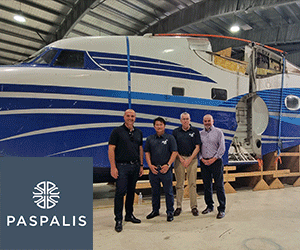1MG FlippingBooks
ResMed’s Quest For Improved Sleep
ResMed founder and chairman Dr Peter Farrell AM depicts the 40-year evolution of sleep apnea treatment, what’s next and how well Australians sleep compared to the rest of the world.

Sleep is an essential part of a healthy lifestyle, but are Australians really aware and appreciative of the value of a good diet and physical exercise?
Compared to the rest of the world, I think Australians probably have a higher-than-average awareness of sleep and obstructive sleep apnea (OSA) thanks to the far-reaching research that’s been conducted and promoted nationwide, celebration of Colin Sullivan, University of Sydney professor, who invented the nasal continuous positive airway pressure (PAP) machine in the early 1980s, and high visibility of ResMed, world leader in connected solutions for treating sleep apnea and an ASX15 company. However, in terms of where awareness should be, it’s still too low for Australians as it is everywhere else. According to Lancet Respiratory Medicine, over 936 million people worldwide have sleep apnea – including over 2.9 million Australians. Over 80 per cent are undiagnosed. We know that leaving sleep apnea untreated – the nightly toll these cyclical suffocations have on our body that should be resting – puts us at 2 to 3 times higher risk for heart attacks or strokes, impacts our daily energy, mood, safety while driving or at work, long-term mental health, and so on. Our sleep health is very much tied to every facet of our overall health and wellbeing.
What is the relationship between sleep and the other two other pillars of public health? Has this been studied and reported on?
The links between sleep and the other two pillars – nutrition and physical exercise – are very strong. Simply put: You can’t optimise your healthy eating or your exercise goals without a good night’s sleep. If you don’t get enough sleep each night – common recommendations are 7 to 9 hours nightly for adults – you may lack the energy required to exercise as much as you’d like to the next day, as well as focus on work and other important tasks.
Lack of sleep also affects how we eat. If you are sleep deprived and lack energy, your body will likely seek more foods high in carbohydrates and/or fat to make up for the energy it didn’t wake up with. What’s worse is sleep deprivation could lead to overeating. A 2013 study published in Psychoneuroendocrinology found sleep-deprived people wake up with greater feelings of hunger and higher plasma ghrelin levels, which are linked to overeating. So not only does good sleep restore our bodily functions and refill our energy tanks for the day ahead, it also enables us to best tend to the other important pillars that help sustain our overall health.
Why is sleep so important to Australia’s national interests and its “socio-economic scorecard” – for example, in terms of productivity, domestic violence, road toll, poverty, mental health, and so on?
A nation’s collective sleep hygiene is key to this scorecard. Sleep deprivation is tied to work absenteeism, presenteeism – which just means you’re at work but not working to your full potential – and workplace and roadway accidents and deaths. Sleep deprivation can also negatively impact our moods, which can in turn affect our relationships, and there’s long-term implications for mental health, too. A 2008 Sleep Medicine Reviews study found sleep disruptions can increase your risk of developing depression. In fact, one in five people with depression are believed to have OSA, according to the U.S. National Sleep Foundation. There are profound benefits for individuals and whole societies in improving our sleep and collectively prioritising good sleep.
Are Australians overall good sleepers? Are there reliable, current statistics available on sleeping disorder prevalence?
Australians get an average 6.8 hours per night, according to ResMed’s own Global Sleep Surveys taken in March 2022 – marginally below 7 to 9 hours per night; not all that bad. But there are two big caveats. One, “average” implies half of Australians are getting less than that amount, and I urge any of those folks to prioritise sleep for their health and quality of life. And two, it is estimated that at least 3 million Australians have sleep apnea, many of them undiagnosed and untreated. Those millions of people may think they’re getting 7 to 9 hours, when in fact their bodies could be waking dozens or hundreds of times a night to prevent mini sleep suffocations caused by their apneas. For these folks, the key to restoring and optimising their sleep begins with diagnosing their condition and treating it at home.
What are some of the latest notable cutting-edge R&D findings, nationally and globally, related to sleeping disorders from cause, treatment, and cure perspectives?
Sleep apnea is an important component of chronic disease. If the sleep apnea is left untreated, many damaging conditions may occur such as hypertension, and eventually type 2 diabetes. There are many other connections between untreated OSA and chronic diseases. The bottom line is that OSA needs treatment otherwise one’s health will significantly deteriorate.
How and where has ResMed expanded scientific knowledge of sleeping disorders in the years since your original article on this subject was prepared?
We can now say that PAP treatment has helped people live longer. The landmark ALASKA study presented at last year’s European Respiratory Society Congress in France showed people with OSA who stayed on therapy were 39 per cent more likely to survive over a 3-year period than OSA patients who didn’t. There were over 176,000 people in this study – and the results held regardless of age, preexisting conditions, overall health, or cause of death. It goes to show how important diagnosis and treatment of this disease really are. ResMed are truly leaders not just in helping the world treat these diseases but in understanding them – how common they are, their effects on other diseases and facets of our health, and what types of digital solutions and other interventions work best in terms of engaging people to start and stay on treatment.
ResMed’s latest global study on the prevalence of sleep apnea found that it affects almost a billion people worldwide, including some 3 million Australians. This study has become one of the most cited resources of prevalence, and people are becoming more aware of how big an issue OSA is if left untreated.
ResMed invests around 7 to 8 per cent of company revenue into R&D to support future growth. What are some notable recent R&D findings?
R&D funds go into improving every aspect of the user’s experience. We continue to push the envelope on digital solutions designed to engage, motivate, and empower users to track and improve their own treatment. This is true across much of healthcare, but ResMed has long been a leader in this space – today there are nearly 18 million connected ResMed devices on bedside tables across 140+ countries. Our latest PAP platform AirSense 11 features new digital solutions; one guides new users onto treatment with confidence, and the other automatically checks in with users at 30, 60 and 90 days and so on to see how they’re doing. And of course, we’re always striving to make the therapy itself smaller, quieter, more comfortable. PAP treatment just turned 40, and in four short decades we’ve made leaps and bounds – from a 10-kilogram machine the size (and noise) of a pool air filter to the ResMed AirMini, which has waterless humidification, runs off your phone, and itself is about the size of an iPhone – the world’s smallest PAP to date, weighing about 0.032 kilograms. Still, there’s much more to unlock; we’re not done improving on these technologies.
Can ResMed’s historic and anticipated contribution to humanity be quantified/estimated?
The COVID-19 years introduced global supply chain challenges, as well as a major competitor recall in our industry. It is undisputed that the need for ventilators at the outset of the pandemic was massive and critical, and I’m incredibly proud of ResMed’s – and frankly all leading ventilator makers’ – ability to produce what we did to meet the world’s demand and save countless lives. ResMed itself pivoted its whole business to make ventilators – it’s usually less than 10 per cent of our business – and set a record: hundreds of thousands of these lifesaving devices were produced in 2020 alone. Today, ResMed is helping fill an historic need for PAP devices in the wake of global supply shortages and a competitor’s recall. We’re talking with suppliers to get the chips we need so millions of people worldwide can get the nightly sleep they require.
Interesting viewing - What Are the Consequences of Sleep Deprivation?










